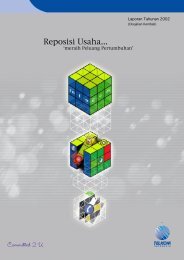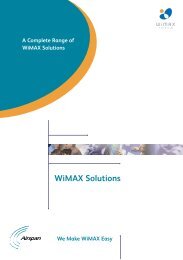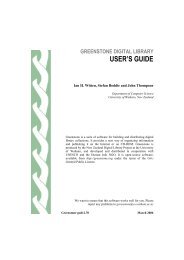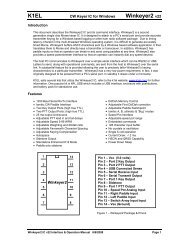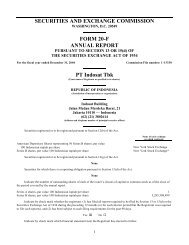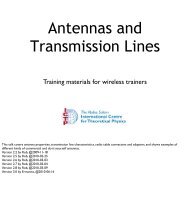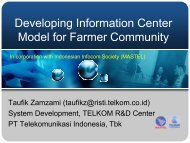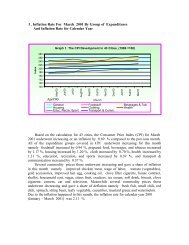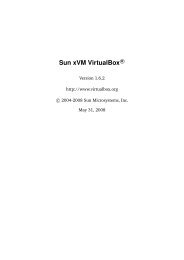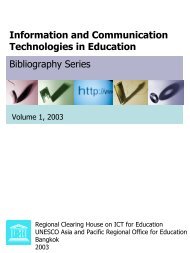Information and communication technologies in schools: a ...
Information and communication technologies in schools: a ...
Information and communication technologies in schools: a ...
Create successful ePaper yourself
Turn your PDF publications into a flip-book with our unique Google optimized e-Paper software.
oriented approach <strong>in</strong>fluences the way children th<strong>in</strong>k about systems of all k<strong>in</strong>ds:<br />
physical, political, <strong>and</strong> economic. But the most important th<strong>in</strong>g is how this<br />
process <strong>in</strong>fluences the way students th<strong>in</strong>k about themselves as human be<strong>in</strong>gs who<br />
create systems, not the other way round.<br />
Basic music composition<br />
Let us consider an example of a design <strong>and</strong> construction activity <strong>in</strong> music.<br />
Traditionally, music classes <strong>in</strong> elementary school concentrate on perform<strong>in</strong>g <strong>and</strong><br />
not on compos<strong>in</strong>g. On the other h<strong>and</strong>, children aged 7 <strong>and</strong> up, with no knowledge<br />
of formal musical notation, can learn how to create simple melodies <strong>in</strong> one<br />
or two years by operat<strong>in</strong>g a computer with an audio synthesiz<strong>in</strong>g <strong>and</strong> edit<strong>in</strong>g<br />
microworld used as a medium <strong>and</strong> tool for structur<strong>in</strong>g <strong>and</strong> shap<strong>in</strong>g the material<br />
of sound. A microworld of this k<strong>in</strong>d provides a choice of musical notes <strong>in</strong> the<br />
range of seven octaves <strong>and</strong> comm<strong>and</strong>s that set a desired pitch, volume, <strong>and</strong> duration<br />
to consecutive str<strong>in</strong>gs of sounds (<strong>and</strong> pauses). Further, the sound can be<br />
given the coloration of any particular <strong>in</strong>strument <strong>and</strong> be made to simulate the<br />
sound of an ensemble of several <strong>in</strong>strumental voices.<br />
The student’s musical work with the computer is divided <strong>in</strong>to three stages<br />
with well-def<strong>in</strong>ed features: a musical scrawl, musical sketch, <strong>and</strong> musical project.<br />
The first stage is <strong>in</strong>discrim<strong>in</strong>ate exploration: each student produces various<br />
sounds for the sheer pleasure of it <strong>and</strong> without pay<strong>in</strong>g much attention to their<br />
quality. After a while, they limit themselves to play<strong>in</strong>g with low or high sounds,<br />
with an emphasis on the duration of the sound. Then students can start to build<br />
small melodies that lack formal structure s<strong>in</strong>ce they are chosen at r<strong>and</strong>om. At this<br />
po<strong>in</strong>t, they are usually more concerned with the duration of the melody than<br />
with the actual sounds. At the end of the first stage, students select the sounds<br />
they like most, name them, <strong>and</strong> create melodies based on these sounds. In this<br />
way, they learn to program the sounds <strong>and</strong> melodies <strong>in</strong> a natural way, because<br />
they have a need to do so. They start to exercise auditory perception <strong>and</strong> to pay<br />
more attention to pitch than to duration.<br />
In the second stage, students usually discover short sounds by chance <strong>and</strong><br />
they start to glimpse the effects of sounds’ parameters (pitch <strong>and</strong> duration). Thus<br />
beg<strong>in</strong>s a period of discrim<strong>in</strong>ate exploration of the musical microworld as they<br />
reflect on each sound’s qualities. The sounds are not chosen at r<strong>and</strong>om anymore.<br />
Duration is the most prom<strong>in</strong>ent sound quality at this stage. The development of<br />
sound appreciation is apparent <strong>in</strong> the exp<strong>and</strong><strong>in</strong>g selection of mean<strong>in</strong>gful words<br />
ICT <strong>in</strong> Learn<strong>in</strong>g <strong>and</strong> Teach<strong>in</strong>g<br />
157




